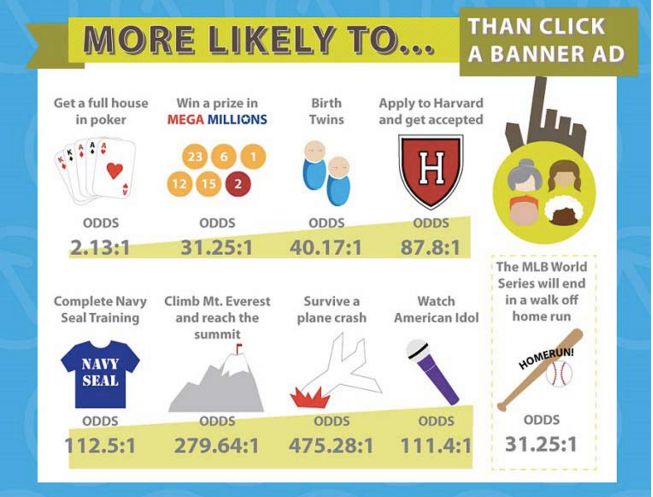
Recent trends have not been kind to disruptive advertising tactics such as banner, display, and PPC ads. It’s been well documented that display ads and PPC are becoming the bane of people’s online existence and ineffectual. The elements that have been the backbone to digital marketing practices are beginning to show their age and according to Unbounce, 98% of advertisers are wasting money on ads.
All you have to do is think about these principles outside of the digital context. How often do you notice billboards when driving on a highway (let alone remember them)? When driving, your intent isn’t to look for advertising, nor are you receptive to the messaging. In this case, the ads are a distraction from your intent and ineffectual. Therefore, if they do not work in this context, why should they in a digital one?
Before getting into some alternatives, let’s first look at the numbers that highlight the current digital advertising and marketing terrain.
10 Stats on Display and Banner Ads
- Display ad viewability rates did not budge between 2013 and 2014. (Source: comScore)
- The average clickthrough rate of display ads across all formats and placements is 0.06% (Source: Display Benchmarks Tool)
- Ad blocking grew by 41% globally in the last 12 months. (Source: PageFair)
- There are now 198 million active ad block users around the world. (Source: PageFair)
- A 2013 study revealed that 28% of respondents admitted to hiding their activities from advertisers — second only to criminals. (Source: Pew Research Center)
- A study revealed that only 2.8% of participants thought that ads on website were relevant. (Source: Infolinks and bannerblindness.org)
- Ad blocking estimated to cost publishers nearly $22 billion during 2015.(Source: PageFair)
- About 50% of clicks on mobile ads are accidental. (Source: GoldSpot Media)
- 54% of users don’t click banner ads because they don’t trust them. (Source: BannerSnack)
- 33% of internet users find display ads completely intolerable (Source: Adobe)

This isn’t a pretty landscape for display ads. Additionally, ad blocking has become increasingly popular. In fact, “ad blocker” was a finalist for the Oxford Dictionary’s “Word of the Year” and this past year Apple introduced ad blocking with iOS9 contributing to a 41% rise in ad blocker use.
Although capturing the amount of ads people see in a day isn’t an exact science, the evidence points to the idea that people are tired of the disruptive tactics. It’s no surprise that people love products like AdBlock, Netflix, and Spotify Premium or watching TV programs through DVR.

Now, let’s tackle the PPC side of disruptive advertising. Recently Wordstream founder, Larry Kim, spoke on the current PPC landscape. Larry noted, “we’ve had a good run. It’s been 15 years, but there are headwinds on the horizon.”
Larry Kim’s PPC ‘Headwinds’
- Paid search CPCs are at an all time high, across Google and Bing.
- Certain verticals are insanely expensive.
- Mobile is responsible for 50%+ of all Google searches.
- There are fewer ad spots on mobile.
- Apps are stealing from desktop searches, people are just opening a Yelp-type app and searching within there.
- 95% of time online is spent consuming content, but only 5% are actually searching for it.
Another ‘headwind’ is Google’s recent announcement that it will remove the display ads from the right-hand side of search results to “enhance search performance,” which seems to be a result of mobile searches surpassing desktop searches and the ads’ low value. This announcement also comes at the same time as LinkedIn’s similar ad placement modifications.
To combat the issue of lowering returns on display ads, Nikao Yang wrote inAd Age about the ability to save ads for future viewing when they are of interest, but not aligned with what a person is trying to achieve at that moment. The concept is an interesting one, but seems to miss the point.
First, how likely are people to have a positive experience when an ad disrupts their motive, and secondly, the question shouldn’t be how can we get people to return to ads, but rather, how do we align content with audiences’ intent?
If only 5% of audiences are searching for content, display ads have a .06% CTR, and 33% are annoyed by disruptive ads — then something needs to change for marketers to be effective.
Brands need to move away from the outdated modes of display ads, disruptive ads, and PPC to align their content where and when their target audiences want to be consuming it. After all, isn’t this what marketing is all about?
The first alternative to disruptive ads is native advertising. Native ads can come in the form of promoted tweets on Twitter, suggested posts on Facebook, sponsored updates on LinkedIn, or anything that is part of the native experience of a channel and doesn’t distract or divert from the user experience. Here we can see why native ads are advantageous because they don’t try to steal attention away from the user’s intent, but instead are a part of it.
Moreover, especially on social networks, targeting is much more sophisticated than for display ads. By utilizing the user data available on these channels, a brand can run all types of tailored content by choosing specific audiences and matching ad variations to these specific audiences.
Beyond interest and demographic targeting, brands can target competitions’ audiences, build mirror audiences based on their followers’ characteristics, cheaper, social followers who are not subscribers, and even life events — just to name a few options. Even ad content can be tested and optimized to deliver the most engaging and effective messaging.
The better user experience, flexibility, and targeting driving better ROI makes native advertising a fantastic option.
Some Examples of Native Advertising Success
- Native ads are viewed 53% more than banner ads. (Source: Dedicated Media)
- Airbnb achieved an engagement rate of over 4% for one of their Promoted Tweets. (Source: Twitter)
- 32% of consumers said they would share a native ad with friends and family, versus 19% for banner ads. (Source: ShareThrough)
- Native ads that include rich media boost conversion rates by up to 60%. (Source: Social Times)
- 71% of publishers received no major complaints from readers for featuring native ads, while 29% received minor backlash. (Source: Digital Content Next)
- After one year of leveraging Targeted Status Updates on LinkedIn, ADP’s Company Page followers doubled to 85,000. (Source: LinkedIn)
Although Buzzfeed offers a mix of sponsored content and native advertising, the company’s perspective does describe native’s core principles quite well:
“BuzzFeed is at the forefront of a major shift in the advertising industry away from traditional banner ads towards ‘social advertising’ that engages consumers, inspires sharing, and produces social lift, or ‘earned media.’”
An extension of native advertising is influencer marketing. Influencer marketing can be loosely defined as a form of marketing that identifies and targets individuals with influence over potential buyers. (Source: Forbes)
According to a McKinsey study, marketing-inspired word-of-mouth generates more than twice the sales of paid advertising, and these customers have a 37% higher retention rate.
On average, businesses generate $6.50 in revenue for each $1 invested in influencer marketing. 70% make $2 or more, and 13% make $20 or more. Most businesses get solid results from influencer marketing, with just the bottom 18% failing to generate any revenue. 22% of marketers say influencer marketing is their most cost-effective customer acquisition channel. (Source: Convince and Convert)
On top of building your brand and improving your sales numbers, influencer marketing also helps your search engine ranking in an organic way. According to the Social Media Revolution, user generated social posts account for 25 percent of search results for the world’s top 20 brands. Both native ads on social channels and influencer marketing to boost brands on search engines by increasing their mentions and search relevance.
In the past, brands may have focused on popular bloggers and celebrities, which is akin to traditional endorsement methods. But, today “everyday” consumers have just as large of an impact in highly influential communities, which can act as increased word of mouth marketing for a fraction of the price.
Lastly, influencers can offer an authenticity, validation, and positive brand reputation that could not be achieved through brand generated content alone. However, influencers must be the drivers of the content and not simply repurposing blanket brand messages for it to be successful. Eric Dahan of MarketingProfs has even gone as far to say that influencer marketing is an antidote to ad blocking because:
“Creating different variations of ads is not the solution to the big old advertising problem. Getting influencers to talk about your products instead of singing your own praises is bound to give marketers more bang for their buck.” — Eric Dahan
Building upon the two previous suggestions, the next logical step with an even larger budget would be to acquire a niche media company. If you’re a listener of “This Old Marketing,” you’ll know this is something content marketing pros Joe Pulizzi and Robert Rose often discuss.
Buying a media company or publication is fairly extreme, or is it? What if a brand could own the carefully constructed content (as opposed to renting ad space on channels), direct communication with an audience, SEO dominance, a proven positive content experience, and reputation that a publication already has? This notion is an amplification of influencer marketing.
Not only could a brand inherit credibility and leadership in the exact niches publications represent, but it could begin to speak directly to and cultivate these speciality areas without alienating its broader audience.
Similar to both native advertising and influencer marketing, owning a media company would carry with it the SERP benefits that can organically trump any PPC, as well.
If media companies in a field don’t already exist, there is ample evidence of brands starting their own to great success, such as Marriott’s Content Studio, Red Bull’s Content Pool, Qualaroo’s Growth Hackers, HubSpot’s Inbound.org, and American Express’ Open Forum.
Another example that has been brought up by the aforementioned Joe Pulizzi focuses on the closing of Grantland. Grantland has been closed since October and still has an audience of close to 1 million people and had 5 million visitors per month! (Source: Business Insider) As Pulizzi notes, more than the benefits previously mentioned in this section, buying a media property also gives a brand direct access to marketing data.
“With Grantland comes a treasure trove of amazing (well indexed by Google) content and a prolific writing team. But more than that, Grantland offers subscribers, who access its content and provide all types of amazing data about what they like, don’t like, and their intent for purchase.” — Joe Pulizzi
Disruptive advertising is still going to exist and remain a fixture for years to come. But, now is the time to think about what can be done in digital marketing and how it can be done better. By seeing and responding to the current trends, brands can begin to set themselves apart by having differentiated advertising and content experiences. The 3 options of native advertising, influencer marketing, and purchasing a media company offer 3 different ways forward based on the type of budget a brand may have available.
By applying disruptive ad tactics, brands run the risk of limited returns resulting in wasted money, or worse off, frustrated audiences leading to negative consumer perception. Now isn’t the time to throw more money into the crowded digital marketing tactics, but to chart new ways forward with unlimited potential.
A version of this post originally appeared on jayshemenski.com.
